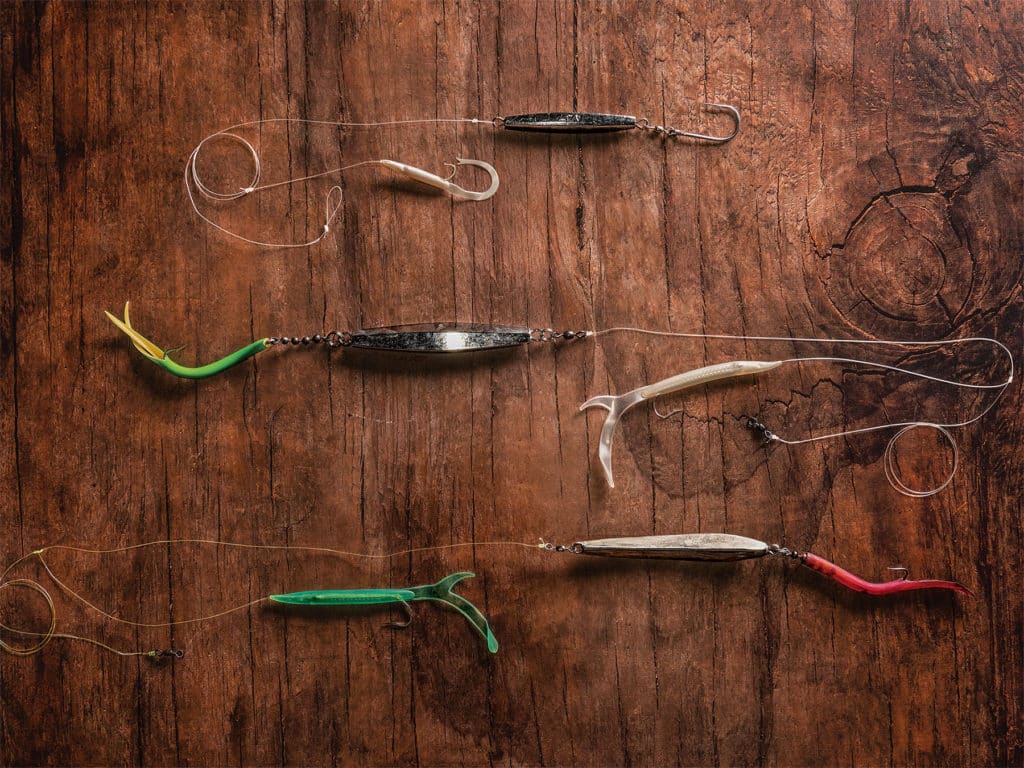
Diamond jigs and their metal cousins are among the simplest yet most effective lures ever created. With reflective chrome plating over a lead core, diamonds are fast-sinking, durable, and easy to fish with a familiar baitfish profile. And unlike plugs covered in menacing treble hooks, the body of a jig provides a safe and sturdy handle with which to lift and unhook feisty fish.
Diamonds can plummet in the strongest current or flutter downward like wounded prey, yet they wobble irresistibly like a fleeing baitfish when retrieved. During hot action, jigs have a speedy turnaround time. As soon as you can wrestle a diamond’s hook from the maw of a scrappy gamefish, you can quickly dump it overboard again.
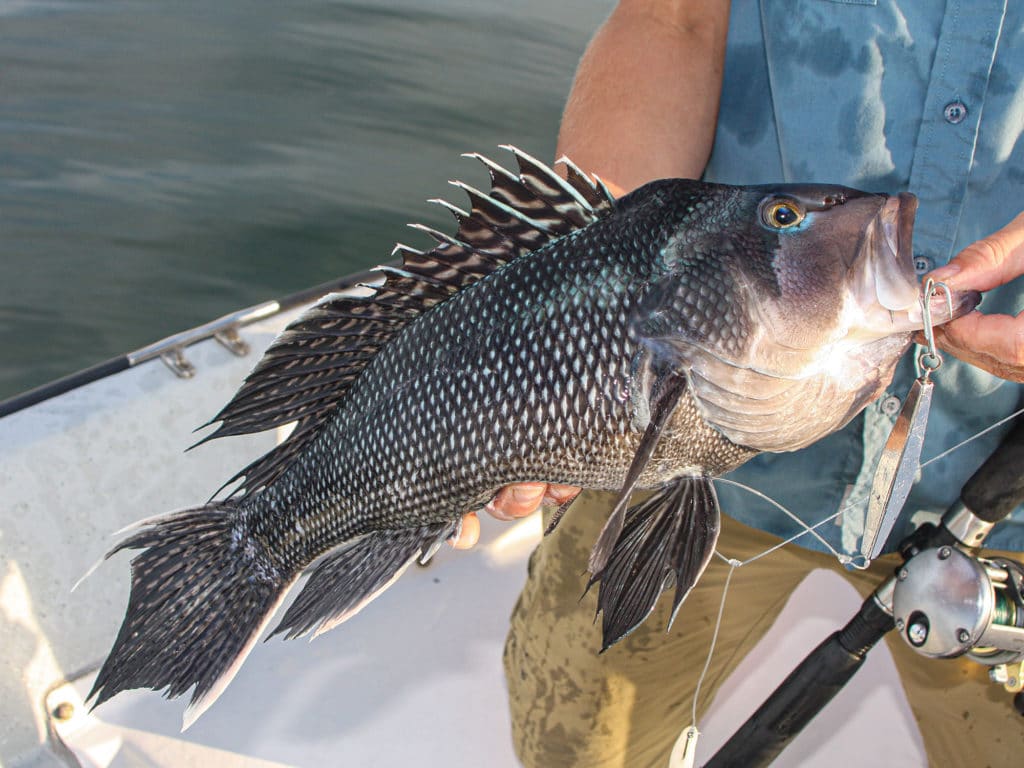
But sometimes the shiny hunks of metal aren’t enough to seal the deal on their own. In those instances, you can often coax hesitant fish into striking with the addition of a dropper fished above a metal jig. This technique gives the illusion of a small predator chasing a wounded baitfish up from the ocean floor, which triggers a competitive reaction in large predators like bluefish, striped bass, cod, pollock, fluke and black sea bass. Of course, there’s always the chance for a double hookup too.
Cod, Pollock and Haddock
One of the masters of diamond jigging in New England is Capt. Ned Kittredge, a pro out of Westport, Massachusetts, with over 45 years of experience. For groundfish, Kittredge modifies standard diamond jigs by attaching droppers above the main lure to prompt cod, pollock and haddock into striking.
He starts by removing the factory hook from a diamond jig, typically attached by a barrel swivel. Working from the opposite end of the jig, he attaches a No. 8 stainless-steel split ring followed by a Bead Chain No. 131 swivel; to that, he adds a 10/0 or 12/0 Mustad 31022DT bent-shank, open-eye Limerick hook. He then slides a 5 ½-inch section of red 3/16- or 1/4-inch (ID) taper-cut latex tubing over the hook, but you can buy them already rigged.
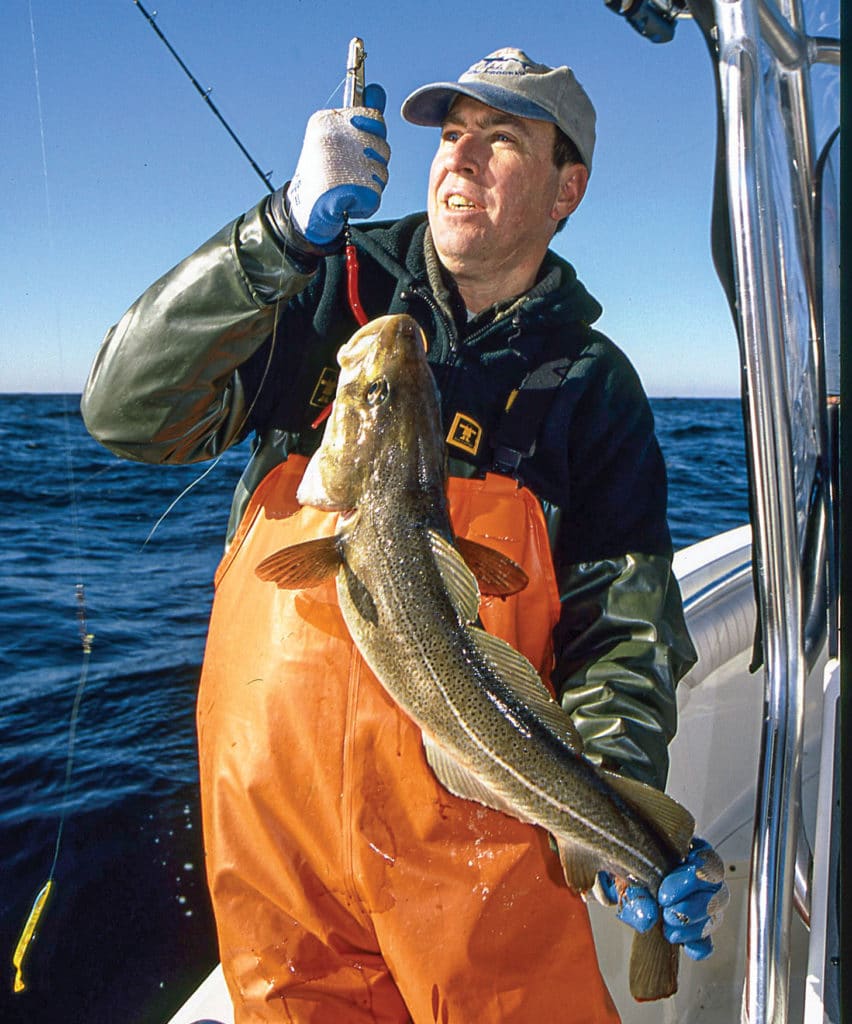
“At slow retrieval speeds,” Kittredge says, “the spiraling tube imitates a sand eel, which cod and pollock love. I then cut two pieces of stiff 80-pound mono leader of about 48 inches each. I tie them together in a blood knot about 24 inches above the diamond jig, snipping one of the tag ends flush with the knot. I thread the other tag, which is about 12 to 16 inches long, through a teaser such as a Red Gill or Felmlee eel and clinch it to a long-shank (Aberdeen) hook pulled back into the tail end of the teaser. I then clinch a large barrel swivel to the running line end of the mono leader about 18 inches above the Blood knot, to which I tie the main line.”
Kittredge cautions against using three-way swivels for the teaser because they’re highly visible and can lead to a fouled rig, ruining the presentation.
Kittredge uses a specialized jigging technique to hook up with Northeast bottomfish. “We ‘squid-jig’ diamonds at a very slow speed,” he says. “Once the lure hits bottom, I slowly crank it up 8 to 50 feet, depending on depth, and then free-spool it down again.
“I retrieve it just fast enough to make the jig’s tube spin, often turning the reel handle dead-slow to account for high-speed reels needed to fish at extreme depth, which creates an irresistible silhouette from below the jig while the teaser flutters above it. That’s what attracts fish to the jig. The secret of the tube’s action is the bead-chain swivel.”
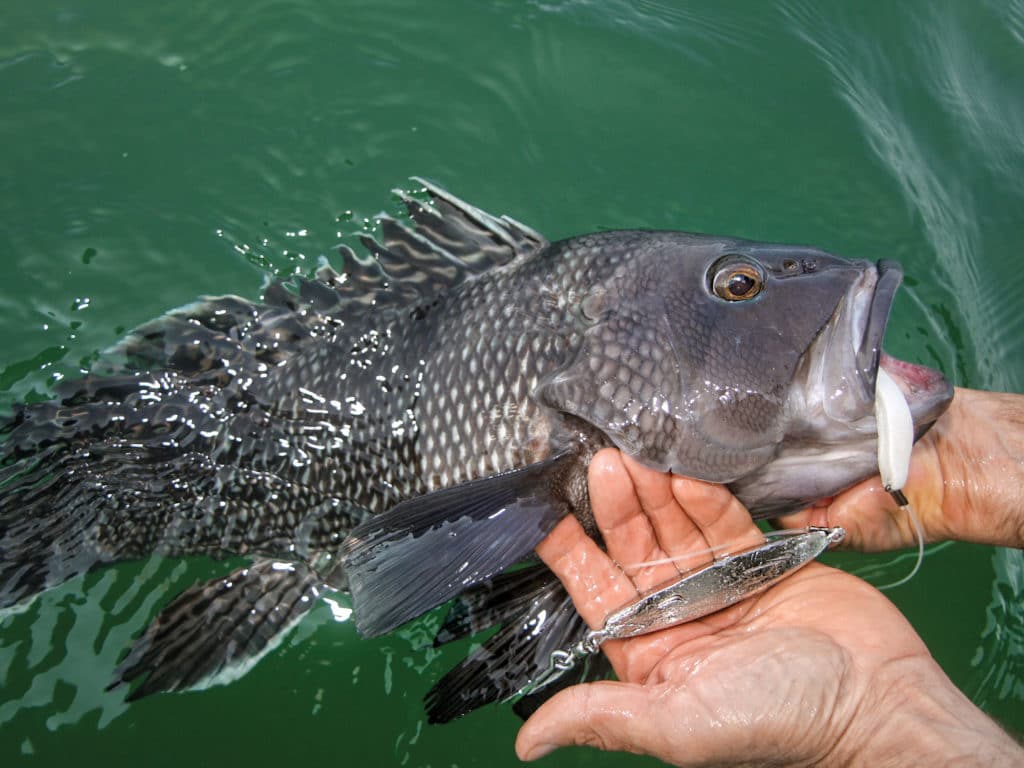
Black Sea Bass
“When fishing black sea bass in shallow water inside areas like Buzzards Bay or Long Island Sound,” Kittredge says, “my preferred jig weight is 3 or 4 ounces. Whatever size hooks are factory-supplied are sufficient; they’re not worth changing out for sea bass. But I like trebles over single hooks if the bottom isn’t too rough.
“The best jig is a 4-ounce Solvkroken stainless-steel Norwegian jig. While all Norwegian jig knockoffs and true diamond jigs are productive for sea bass when fished properly, the curved shape of a Solvkroken allows it to flutter well on the drop, which attracts big fish.”
Experienced fishermen agree that jigs often outfish standard high-low bait rigs for the biggest sea bass by keeping smaller fish and porgies at bay, but many experts enhance their odds by tying in a dropper teaser above the jig.
“I don’t use bait anymore,” Kittredge says. “Sea bass are hungry and aggressive. I’d rather not deal with bait if I don’t have to. Sometimes I fish with just a Solvkroken jig, but if the fish are thick or suspended above the structure, a teaser is a good idea. I find the sea bass mostly strike the jig, but they do hit the teaser, and sometimes you’ll land a double.”
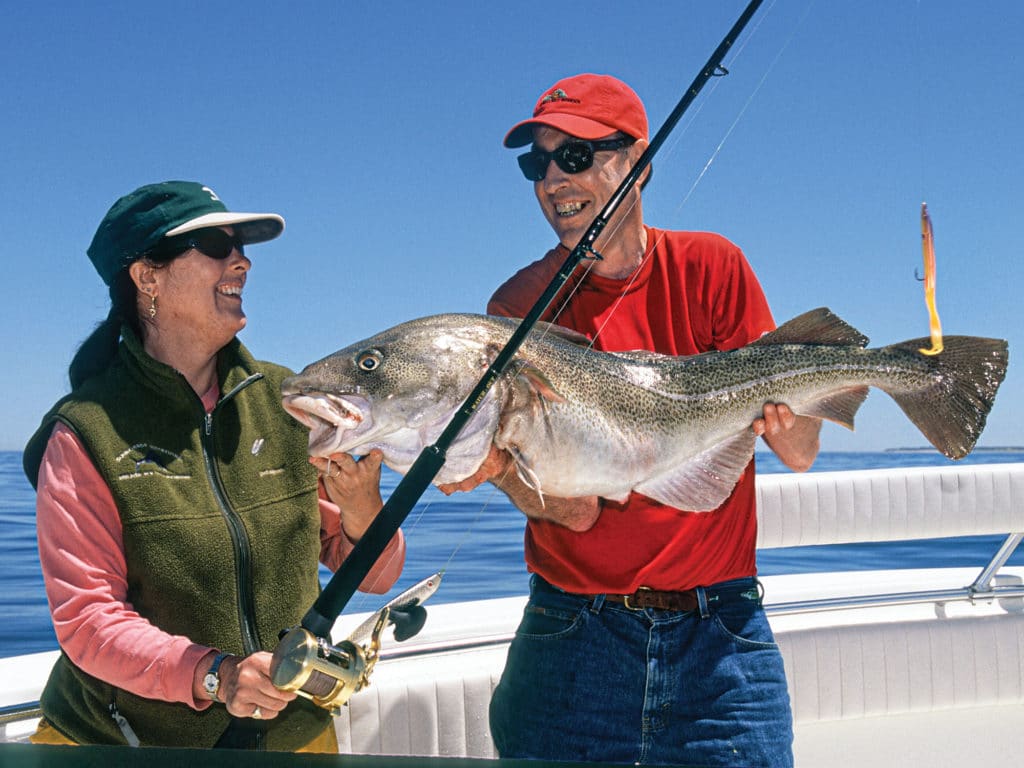
Because a large teaser can affect the way a jig fishes, Kittredge downsizes to the smaller 65 mm white or green Delta eel in fast currents. He says that those still fish well but don’t impair the sink rate or the action of the small jigs. This combination also yields fluke as a bonus bycatch.
“There’s something unique to the Norwegian jig’s action,” he adds. “I think the fluke are really attracted to it. And when you get into a cluster of schoolie stripers, the action can be red-hot with a teaser-jig combination.”
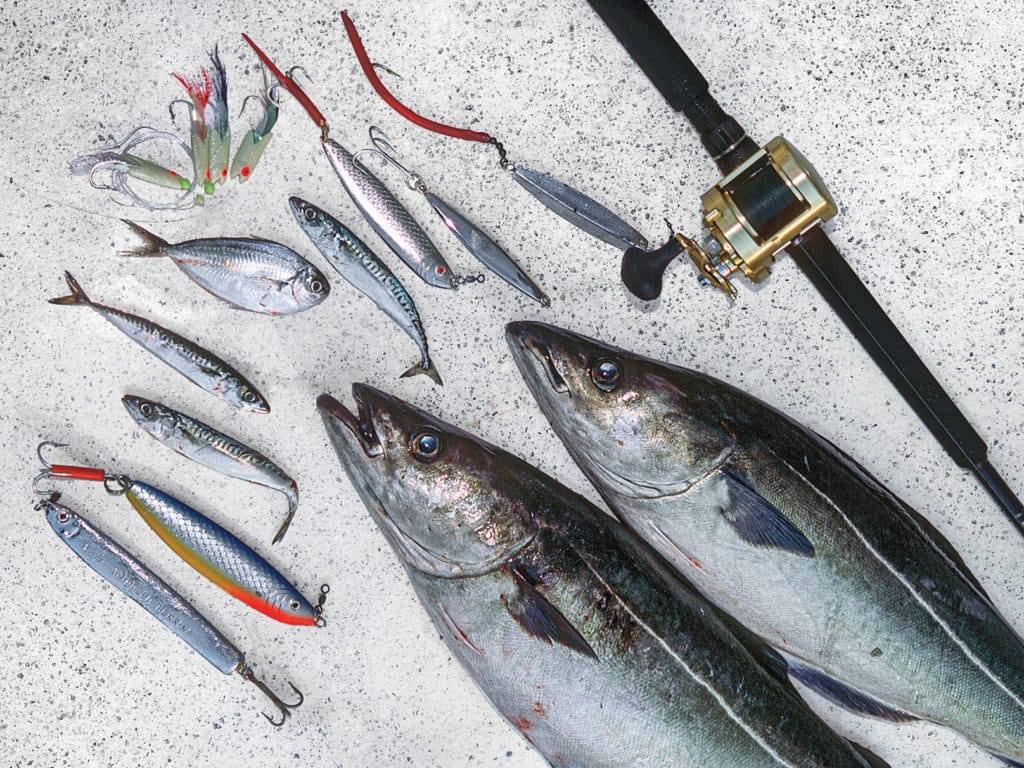
Kittredge cuts a 36-inch length of 60-pound fluorocarbon or Perlon, which is ideal because of its stiffness, for leader. He cuts another short trace to attach to the jig, and joins the two pieces with a uni-knot to uni-knot about 12 inches above the lure, leaving the upward-facing leg about 6 inches long as a dropper for the teaser. Here, he clinches on a Gamakatsu 3/0 or 4/0 bait holder or similar hook, while clipping the other end close to the knot.
Other soft plastics work well for sea bass teasers. Try a 4-inch Zoom Salty Super Fluke, curly-tail Got-Cha or Felmlee, Lunker City Slug-Go or Fin-S Fish. If you stock just one color, make it white, which mimics most baitfish and squid. Another good bass teaser option is an unweighted or epoxy-head white bucktail, which you can sweeten with a squid strip. And then hold on for some hot action.
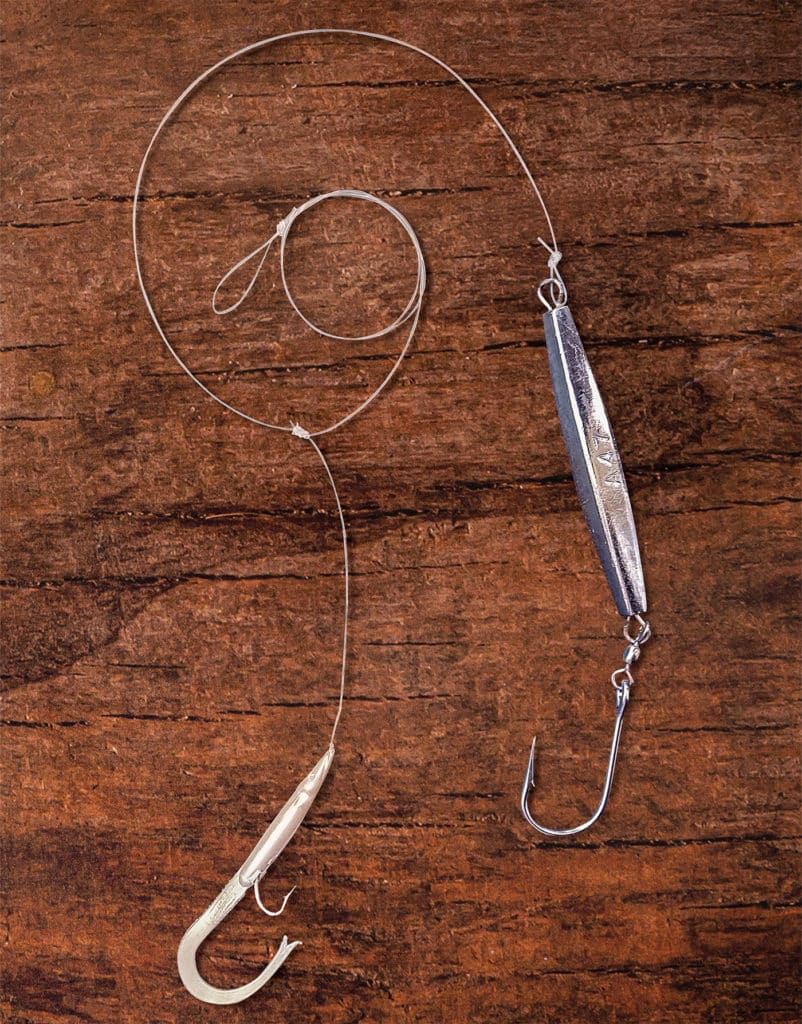
Three Rigs for Jigs
There are three basic options to attach a main line to a diamond-jig leader.
The first utilizes a line-to-line knot, which allows you to reel a long leader through the rod guides and even down onto the reel.
The second involves a large barrel swivel, which is tied on the main line with a Palomar knot. To detach the jig for storage or transportation, just snip the leader at the swivel, coil the leader, and clinch it back on next time.
The third uses a Palomar knot to attach the main line to a cross-lock snap swivel. A loop knot is tied in the leader, which allows it to clip to the snap. This method is handy for changing out different jig weights depending on the conditions. Stiff leader is easily coiled and remains with the jig.
You can tie a simple clinch knot to attach the leader to a diamond jig. But tying a nonslip loop knot to the jig’s eye provides less restriction and more flutter action.









